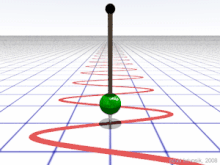Lozt in {Trans}mission jwould {pre} vent {{{(tran){s[lat]}[[ion]zZzization]}}} what did billy whieyezpeer
Frequency
| Frequency | |
|---|---|
Common symbols | f, ν |
| SI unit | hertz (Hz) |
Other units |
|
| In SI base units | s−1 |
Derivations from other quantities |
|
| Dimension | |
Frequency is the number of occurrences of a repeating event per unit of time.[1] It is also occasionally referred to as temporal frequency to emphasize the contrast to spatial frequency, and ordinary frequency to emphasize the contrast to angular frequency. Frequency is expressed in units of hertz (Hz) which is equivalent to one (event) per second. The corresponding period is the time duration of one cycle in a repeating event, so the period is the reciprocal of the frequency.[2] For example, if a heart beats at a frequency of 120 times a minute (2 hertz), its period, T—the time interval between beats—is half a second (60 seconds divided by 120 beats). Frequency is an important parameter used in science and engineering to specify the temporal rate of change observed in oscillatory and periodic phenomena, such as mechanical vibrations, audio signals (sound), radio waves, and light.
Definitions and units[edit source]
For cyclical phenomena such as oscillations, waves, or for examples of simple harmonic motion, the term frequency is defined as the number of cycles or vibrations per unit of time. The conventional symbol for frequency is f; the Greek letter (nu) is also used.[3] The period is the time taken to complete one cycle of an oscillation.[note 1] The relation between the frequency and the period is given by the equation:[5]
The term temporal frequency is used to emphasise that the frequency is characterised by the number of occurrences of a repeating event per unit time, and not unit distance.
The SI derived unit of frequency is the hertz (Hz),[5] named after the German physicist Heinrich Hertz by the International Electrotechnical Commission in 1930. It was adopted by the CGPM (Conférence générale des poids et mesures) in 1960, officially replacing the previous name, "cycles per second" (cps). The SI unit for the period, as for all measurements of time, is the second.[6] A traditional unit of measure used with rotating mechanical devices is revolutions per minute, abbreviated r/min or rpm. 60 rpm is equivalent to one hertz.[7]
Wind-generated waves are described in terms of their period rather than frequency.[8]
ZACHAROPLASTEÍA


 (
(

Comments
Post a Comment
No Comment